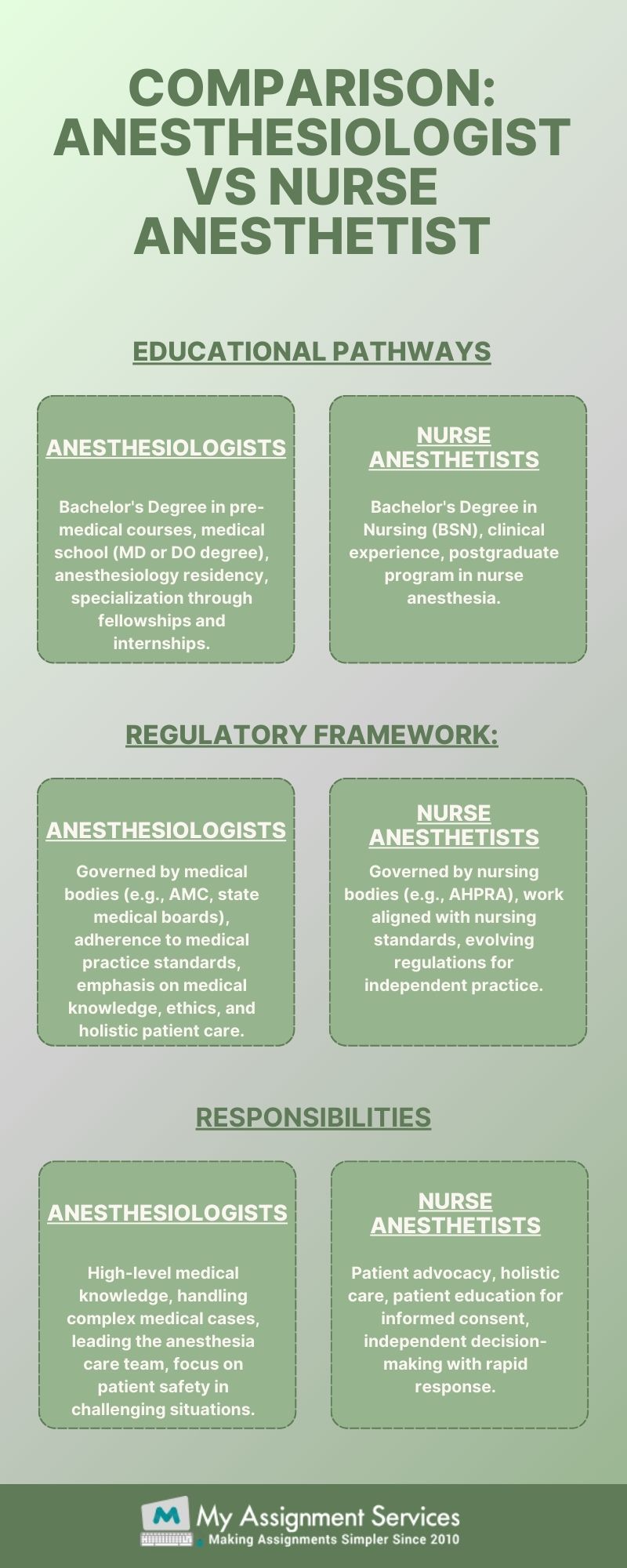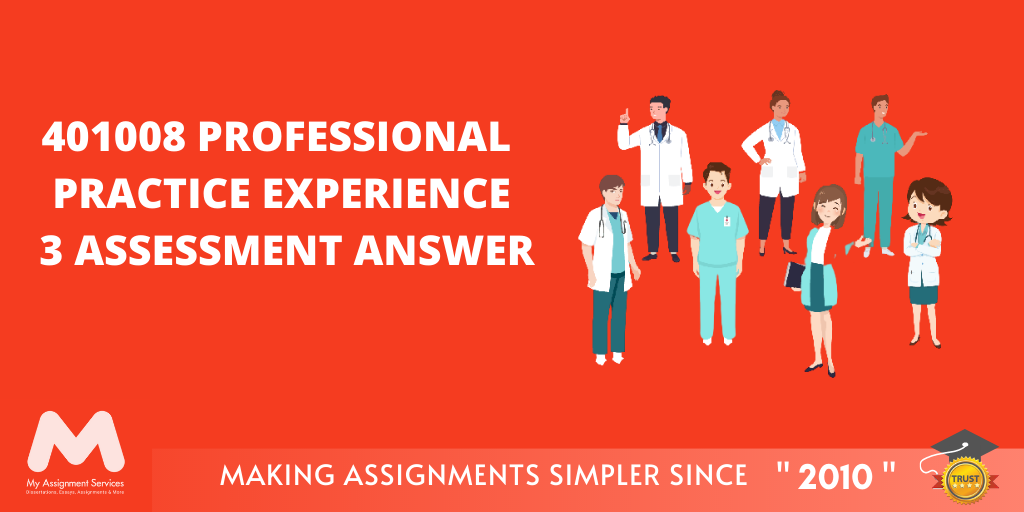In the health care sector in Australia, nurse anesthetists and anesthesiologists function as complementary allies that support patients during medical treatment. Owing to the complexities of anesthesia care, students must pay special attention to studying these specialized roles. Additionally, they can seek nursing assignment help to focus on how the two professions present themselves under Australian medical conditions. This blog investigates the differences between these professions, revealing their specific roles, educational journeys, and impacts on the national healthcare structure. This is a crucial point of discussion for nursing students studying the careers followed by both experts. Although seen as the same profession, medical students must understand the difference between the two degrees before starting their medical journey.
Understanding the Roles of Nurse Anesthetist VS Anesthesiologist
Although Nurse Anesthetists and Anesthesiologists in Australia share the common objective of delivering safe and effective anesthetic care, their roles within a typical anesthetic team differ.
Nurse Anesthetist:
Certified Registered Nurse Anesthetists or CRNAs are well-trained and highly specialised nurses specializing in anesthesia. Their role is highly dynamic and multidimensional, including various duties. CRNAs provide anesthesia services to surgeons, anesthesiologists and other healthcare providers within different healthcare environments.
Medical students can use various nursing portfolio examples to understand their duties. Their main responsibilities comprise taking patients' medical records, planning anesthesia care plans, and administering medication anesthesia. Autonomy is another noteworthy feature of the Nurse anesthetist function, as they frequently work in isolation when administering anesthetic care.
Anesthesiologist:
Anesthesiologists are medical doctors who specialise in anesthesiology. Their function is defined by broad medical knowledge and expertise in handling patients during surgery. Anesthesiologists head the anesthesia care team, working with Nurse Anesthetists, surgeons, and other health practitioners. In studying the role of anesthesiologist vs. nurse anesthetist, students must pay closer attention to the duties.
Their broad knowledge and training in medical practice give them the special position to address complicated medical issues and develop anesthesia approaches to individual patient needs. Anesthesiologists play significant roles in decision-making, especially in high-risk cases or emergencies. Their scope of practice is not limited to giving anesthesia but also covers managing health complications, pain management, and sometimes even working in critical care.
Comparison between Anesthesiologist and Nurse Anesthetist
While both professions have undertaken many responsibilities, ranging from medical assessments to planning and implementing the anesthetic regime and monitoring patients during surgical procedures, there are certain differences between the two. The major differences arise based on their educational journey, duties, and the regulatory framework binding them. Check the points below to understand each difference in detail.
Educational Pathways
The educational journey for both professions is completely different. It arises in different fields and demands unique requirements. To understand more, students can seek nursing assignment help to reflect proper details in their papers.
Nurse anesthetists take a nursing-oriented academic path. They usually start with a Bachelor's Degree in Nursing (BSN), which helps them build their foundation on nursing principles. Then, they acquire clinical experience in different nursing specialities and obtain fundamental skills in patient care. Their course finishes with a postgraduate program in nurse anesthesia. Additionally, these nurses have to be specially trained to provide anesthesia care.
Contrary to nurse anesthetists vs. anesthesiologist, the latter has a comprehensive medical education. They start with a Bachelor's Degree in pre-medical courses. Then, they go to medical school, usually a four-year program, and obtain an MD or DO degree in medicine. The next phase is an anesthesiology residency program lasting a few years. This training prepares the student for the complications of anesthesia practice, including surgical care, pain management and critical care. Anesthesiologists may also specialise through fellowships and internships.
Regulatory Framework
The regulations governing Nurse Anesthetists and Anesthesiologists in Australia reflect how these professions are positioned within the healthcare system. For studying, they are the governing bodies for the students.
Nurse Anesthetists conform to standards established by nursing regulating bodies, including the Australian Health Practitioner Regulation Agency AHPRA. Students can seek anesthesia or regular or even cardiac nursing assignment help to understand the bodies in detail. The work of the practitioners is informed by nursing standards that promote a person-centred approach and teamwork in the anesthesia care group. Nurse Anesthetists work freely, and their regulations may change to reflect the widening nature of nursing practice.
Anesthesiologists, like medical doctors, fall under the jurisdiction of boards and regulatory bodies that oversee medical practice. Anesthesiologists are governed by the Australian Medical Council (AMC) and state medical boards' standards guidelines. The regulatory framework details medical knowledge, ethical practice and holistic patient care from Anesthesiologists alongside the difficulties and accountability. They exist to measure each step of the profession and guide them further.
Responsibilities
Nurse Anesthetists VS Anesthesiologist each play significant roles in patient care, bringing unique strengths to the anesthesia team. Despite different steps and measures, they aim to promote similar results.
Nurse Anesthetists perform well in patient advocacy, communication and the holistic approach to care with their nursing background. The nurses focus on patient education to ensure informed consent and emotional support, followed by anesthesia management that considers each individual's unique needs. Since they can make decisions independently, their response time is rapid in different clinical environments. Students can also seek nursing assignment help services to better understand practices.
Read More: A Comprehensive Guide to Nursing Informatics
As physicians, anesthesiologists bring high-level medical knowledge to patient care. Specialists deal with complicated medical cases involving critical conditions and give anesthesia plans depending on the specifics. Anesthesiologists are at the forefront of the anesthesia care team, guiding extensive care. They handle issues related to complications that can arise, pain management and critical care. Their main motive is improving patient safety, especially in difficult circumstances. They lead a cooperative team and never sway from their goals.

Medical Harmony with Anesthesiologist V/S Nurse Anesthetist
The unique functions of a Nurse Anesthetist and that of an Anesthesiologist come together to create a perfect partnership while working as the anesthesia care crew. Though Nurse Anesthetists add a nursing perspective and reinforce the values of autonomy and patient advocacy, Anesthesiologists provide a broad understanding of medical knowledge and leadership. They come together as a collaborative group to ensure that operative care is special, safe and effective. By highlighting the respective contributions of each in creating a well-established healthcare environment, students can understand better. To make better decisions, students can also study different nursing portfolio examples to choose a specific direction.





